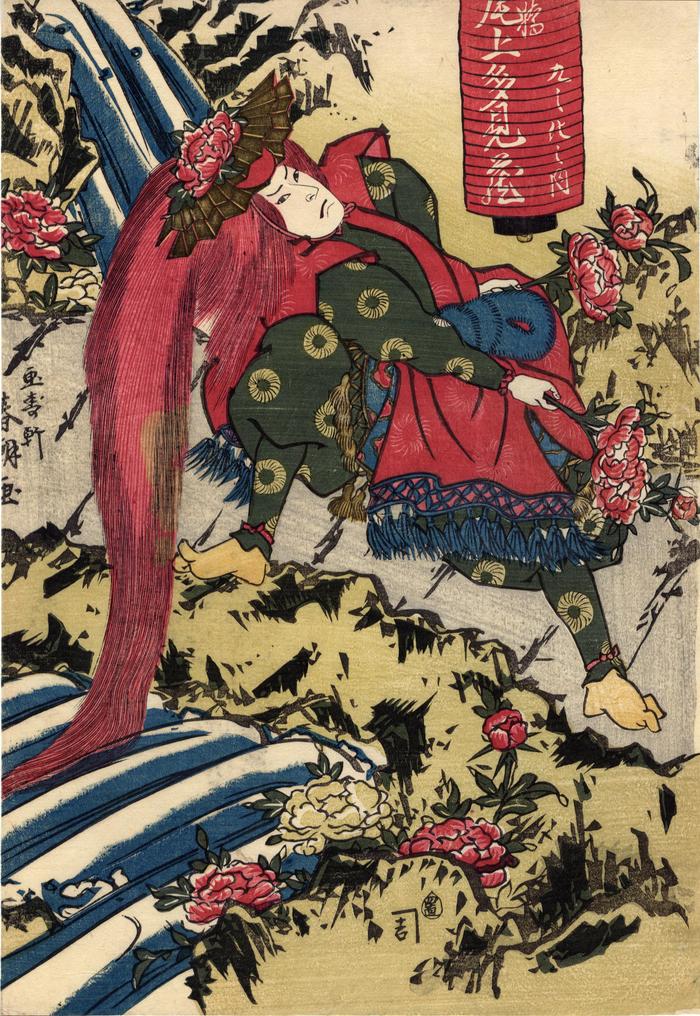Gajuken Shunchō (画寿軒春潮) (artist )
Onoe Tamizō II (二代目尾上多見蔵) in the lion dance Shakkyō (Stone Bridge) scene from Kokonobake no uchi (A Set of Nine Changes - 九之化之内 - seen in the lower right of the collapsible lantern)
ca 1828
10 in x 14.75 in (Overall dimensions) Gajuken Shunchō ga (画寿軒春潮画)
Publishers: Kichi (Marks U140 - seal closest to 06-012)
and Honya Seishichi (Marks 123 - seal 13-004)
Lyon Collection - another Tamizō II print from this series
Lyon Collection - a third example from this series
Lyon Collection - a fourth example from this series
Lyon Collection - a fifth example from this series "Stone Bridge (石橋), a reference to the bridge in the Nō play Shakkyō, involves a traveler who falls asleep beside a stone bridge and dreams of a lion dancing among peonies. The lion dance appeared in kabuki possibly as early as the late seventeenth century, although the earliest surviving example appears to be dated 1734. Afterwards many variations of the dance were performed, including a lion dancing with peonies, a maiden possessed by the spirit of a lion mask, a lioness and her cub dancing together, and a lion tormented by butterflies. Each dance ends with the actor in a lion headdress waving an impressively long mane back and forth. The genre of lion dances (shishi mai) is called shakkyô mono (stone-bridge pieces: 石橋物) and derive from ancient gigaku (伎楽) dances."
Quoted directly from Osakaprints.com.
"Onoe Tamizô performs the dynamic hair-washing scene (kami arai: 髪洗い) from a kabuki adaptation of the Nō play Shakkyō. In this production Tamizō performed nine roles through quick-changes (hayagawari: 早替) of costume and acting/vocal styles (also considered a type of henge-mono or transformation piece: 変化物). These displays of acting and dancing skills were great crowd-pleasers in the kabuki world. Prints for other roles in Tamizō's performance were designed by Gakōken Shunshi and another of Shunshi's pupils, Gayūken Shunsei." (Ibid.)
****
Maude Rex Allen wrote in 1917 in Japanese Art Motives on page 29: "The peony was brought to Japan in the eighth century from China, where it is one of the plants of the four seasons - the flower of summer. As an art motive, Japan is indebted to Korea for the wonderful variety of adaptation in showing this gorgeous flower."
"Because of the size and beauty of its crimson blossoms, the peony is an emblem of regal power. It is associated with the kara-shishi or Chinese lion - the king of beasts and the king of flowers. Another interpretation of this combination is given:"
In art, the peony is represented among the rocks with kara-shishi, a Chinese association, known as the botanni-kara-shishi, which may illustrate the theory of the survival of the fittest, for it is said that of the cubs which fall to the ground amongst the bushes of the peony, only the strongest succeed in rejoining their mother by climbing the rocks and thus attaining maturity." Allen is citing J. L. Bowes's book, Japanese Pottery on page 495.
****
Illustrated in Osaka Prints by Dean Schwaab, 1989, no. 116, page 131. This impression is from the Haber Collection. Prints from this collection are admired for their fine color preservation, and often for their rarity, as with this design." (Ibid.)
Here are Schwaab's notes about this image: "This is probably the finale piece to the set of nine changes... In this abuki adaptation of the Nō play, a traveller falls asleep beside a stone bridge and dreams of a lion playing among peonies. The climax of the performance, where the lion waves his long red mane from side to side, is called the kami arai, or hair washing, which is literally portrayed here."
Onoe Tamizō II (二代目尾上多見蔵: 11/1820-1848; 1850-November, 1885) (actor)
actor prints (yakusha-e - 役者絵) (genre)
Kyōto-Osaka prints (kamigata-e - 上方絵) (genre)
Honya Seishichi (本屋清七) (publisher)
